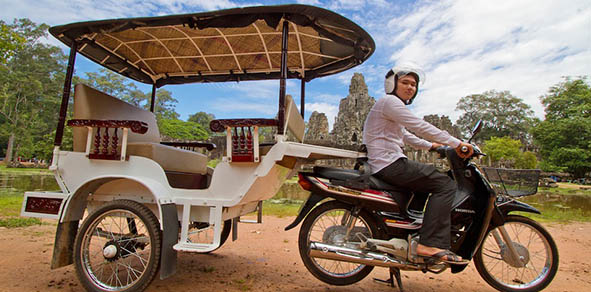THINGS TO DO IN SIEM REAP
Angkor literally means Capital City or Holy City. Khmer refers to the dominant ethnic group in modern and ancient Cambodia. In its modern usage, ‘Angkor’ has come to refer to the capital city of the Khmer Empire that existed in the area of Cambodia between the 9th and 12th centuries CE, as well as to the empire itself. The temple ruins in the area of Siem Reap are the remnants of the Angkorian capitals, and represent the pinnacle of the ancient Khmer architecture, art and civilization.
Beside the temples of Angkor there still be a lot of things to see and do around Siem Rea. Seeing a bit of Cambodia away from the temples can help you get more experiences as well as help Cambodia by taking some tourist pleasure off of the temples and spreading the tourism currency more widely.
In additional to the following suggestions, figure out the sections on shopping at the night markets, visit the Tonle Sap lake and take boat ride to see the floating village and bird sanctuary, attending a traditional dance performances with buffet dinner, cooking class with Khmer recipes, going on helicopter, balloon and elephant rides and so on...
Angkor Thom
Angkor Thom was built by Angkor’s greatest king Jayavarman VII (ruled 1181-1219). It is enclosed by a square wall 8 m high and 12 km in length and encircled by a moat 100 m wide. The city has five monumental gates, one each in the north, west and south walls and two in the east wall. The gates, which are 20m in height, are decorated to either side of the passageway with stone elephant trunks and crowned by four gargantuan facing the cardinal directions. In front of each gate stand giant statues of 54 gods and 54 demons. In the center of the walled enclosure are the city’s most important monuments, including the Bayon, The Baphuon, Vimean Akas, The royal Enclosure, Terrace of Elephants, Preah Phalilay, Tep Prornam and Prasat Suor Prat.
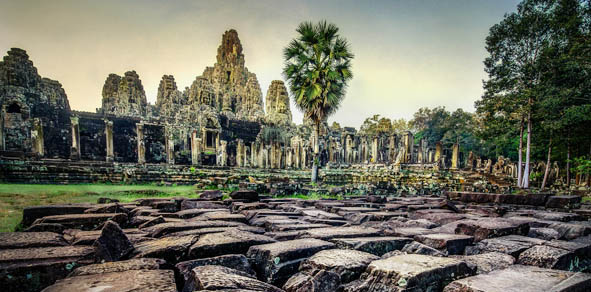
Angkor Wat
One of the true wonders of the world and built to honor the Hindu god Vishnu, Angkor Wat is the world’s largest religious building which took some 50,000 artisans, workers and slaves, and nearly 40 years to complete. The temple forms a rectangular enclosure measuring 1,500 meters by 1,300 meters surrounded by a moat 200 meters wide. The main entrance to Angkor Wat is a paved avenue nearly half a kilometer long, ornamented with balustrades and fringed by artificial lakes. Inside the outer walls, the structure raises over three levels to a central core topped by five pineapple-shaped towers. Virtually every surface in the maze of chambers and courtyards is richly decorated with low- relief scenes of legends, carvings of nearly 2,000 Apsaras or celestial dancers.
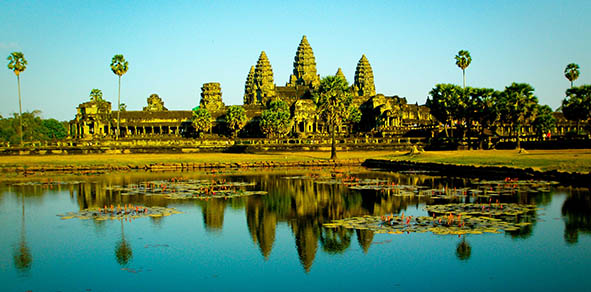
Bayon Temple
Bayon Temple was built in late 12th and early 13th century by the king Jayavaman VII and dedicated to Buddhism. The Bayon is at the center of Angkor Thom (literally” Great City”), which forms the heart of the Angkor complex as it is today. The Bayon remains one the most enigmatic temples of the Angkor Group. Its elements juxtapose each other to create balance and harmony. Bayon is the place of stooped corridors, precipitous flights of stairs and most of all, a collection of 54 gothic towers decorated with over 200 smiling Gargantuan faces of Avalokiteshvara. A number of Cambodian people point out that the Khmer Empire was divided into 54 provinces at the time of the Bayon’s construction, hence the all seeing eyes of Avalokiteshvara were keeping watch on the Kingdom’s far-flung subjects.
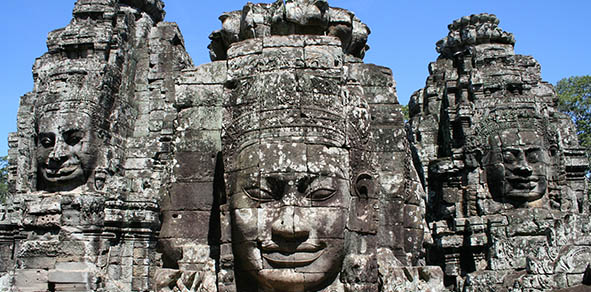
South Gate of Angkor Thom
nown as Yashodharapura, the South Gate of Angkor Thom is the nearest point of entry to the royal city of Angkor Thom from Angkorwat (and Siem Reap). There are five entrance gates to Angkor Thom – one at each cardinal point and a Victory Gate, which is on the eastern wall and affords access to the royal palace area, but South Gate is hands down the most popular and the most congested. All of the Angkor Thom gates look virtually the same, but because South Gate is the point of entry for vast majority of visitors to Angkor Thom, this gate is the most complete thanks to extensive restoration works. Just as most tourists do, I started my Angkor adventure with Angkor Wat too, which had me enter Angkor Thom through South Gate.
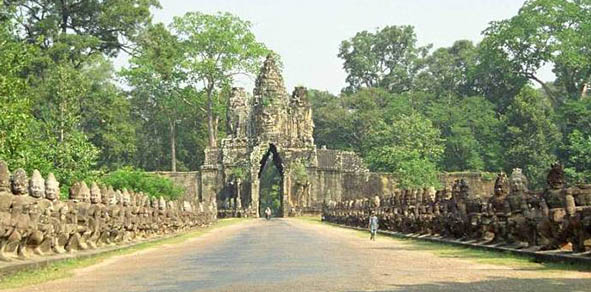
Sun Rises at Angkorwat Temple
Getting up at 5am for sunrise at Angkor Wat is an absolute must do while in Siem Reap. If you are lucky enough to get a morning with just the right amount of cloud cover the sky transforms at 5:45 from inky navy blue to crimson, pink and red as the sun begins to climb over the horizon. You first approach the central temple area down a long walkway just as the sky is beginning to lighten. Standing in front of the lotus pond the sawtooth outline of the five main towers are silhouetted against a brightening pink and blue morning sky. The most popular place to watch the sunrise at Angkor Wat is in front of the left side lotus pond. Just follow all of the other people, there will be hundreds.Regarding the crowds, if you thought that sunrise would be a peaceful, maybe even a spiritual experience, you will be sadly disappointed. Depending on the day you will likely be jockeying for photos with hundreds of other tourists. The short video below gives you a sense of the background chatter and noise you can expect. Just know what you can expect and enjoy it despite the crowds.
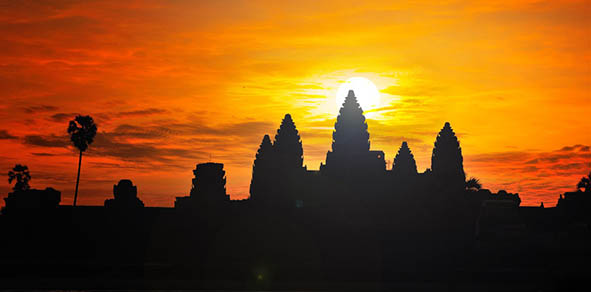
Sunset at Phnom Bakheng
Phnom Bakheng at Angkor, Cambodia, is a Hindu temple in the form of a temple mountain. Dedicated to Shiva, it was built at the end of the 9th century, during the reign of King Yasovarman (889-910). Located atop a hill, it is nowadays a popular tourist spot for sunset views of the much bigger temple Angkor Wat, which lies amid the jungle about 1.5 km to the southeast. The large number of visitors makes Phnom Bakheng one of the most threatened monuments of Angkor. Depending on the day you will likely be jockeying for photos with hundreds of other tourists. The short video below gives you a sense of the background chatter and noise you can expect. Just know what you can expect and enjoy it despite the crowds.
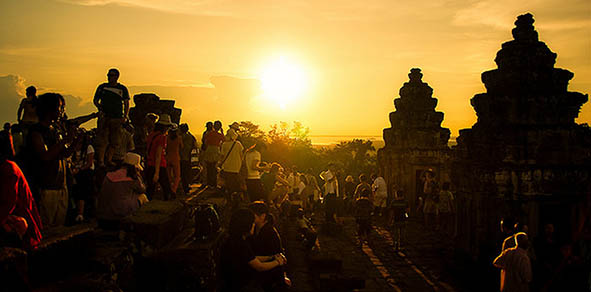
Ta Prohm Temple or Jungle Temple
Ta Prohm is the modern name of a temple at Angkor, Siem Reap Province, Cambodia, built in the Bayon style largely in the late 12th and early 13th centuries and originally called Rajavihara. Located approximately one kilometre east of Angkor Thom and on the Southern edge of the East Baray, it was founded by the Khmer King Jayavarman VII as a Mahayana Buddhist monastery and university. Unlike most Angkorian temples, Ta Prohm has been left in much the same condition in which it was found: the photogenic and atmospheric combination of trees growing out of the ruins and the jungle surroundings have made it one of Angkor's most popular temples with visitors.UNESCO inscribed Ta Prohm on the World Heritage List in 1992. Today, it is one of the most visited complexes in Cambodia’s Angkor region. The conservation and restoration of Ta Prohm is a partnership project of the Archaeological Survey of India and the APSARA (Authority for the Protection and Management of Angkor and the Region of Siem Reap).
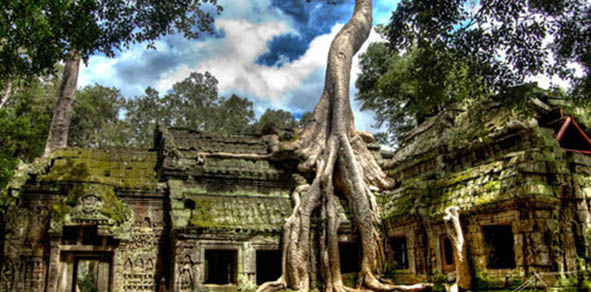
Banteay Srei or Pink Temple
Banteay Srei or Banteay Srey is a 10th century Cambodian temple dedicated to the Hindu god Shiva . Located in the area of Angkor in Cambodia. It lies near the hill of Phnom Die , 25 km (16 mi) north-east of the main group of temples that once belonged to the medieval capitals of Yasodharapura and Angkor Thom. Banteay Srei is built largely of Red Sandstone, a medium that lends itself to the elaborate decorative wall carvings which are still observable today. The buildings themselves are miniature in scale, unusually so when measured by the standards of Angkorian construction. These factors have made the temple extremely popular with tourists, and have led to its being widely praised as a "precious gem", or the "jewel of Khmer art."
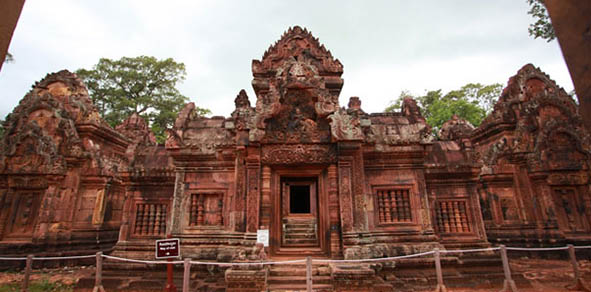
Floating Villages
Floating Village's are much more than just Siem Reap attractions and can be found all over the Tonle Sap lake providing essential housing to those who make their livings from the various industry that the lake provides. Some are huge communities, some merely small dwellings of several hundred or leas, Chong Kneas is the first you will discover if heading to the lake from Siem Reap. Perhaps not quite as impressive as some of the larger villages or stilted communities such as Kompong Khleang in terms of sheer magnitude, this is nevertheless traditional Cambodian life at its best, and the way people live their lives out here is a sight to behold as the scores of fisherman, market vendors, boat makers or craftsmen go about their daily business.
Chong Kneas is a remarkable testament to the adaptability of these people who reside on the very waters of the lake, and is most definitely worth a visit, being one of the most productive fishing areas in the whole of Cambodia. However, owing to its proximity to Siem Reap, you will share any visit to the village with a high volume of tourists. If pushed for time Chong Kneas is a must, but otherwise we'd recommend heading out a little further to see some of the less visited floating communities or stilted villages.
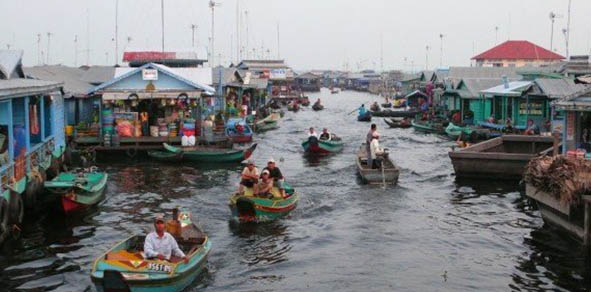
Beng Melea
Sprawling jungle temple covering over one square kilometer. The temple is largely overrun by vegetation and very lightly tourist, giving it an adventurous, ‘lost temple’ feel. Photographers: trees growing from the broken towers and galleries offer some of the best ‘tree in temple’ shots aside from Ta Prohm. Constructed in a distinctly Angkor Wat style under the same king that built Angkor Wat, Beng Melea preceded and may have served as a prototype of sorts for Angkor Wat. Though there are some lintel and doorway carvings, there are no bas-reliefs and the carvings are comparatively sparse. When the temple was active, the walls may have been covered, painted or had frescos. In its time, Beng Melea was at the crossroads of several major highways that ran to Angkor, Koh Ker, Preah Vihear (in northern Cambodia) and northern Vietnam. Regular admission ticket are not required but there is a separate $5 entrance fee. Beng Melea is located 63km east of town. The road is now in good condition and the trip from Siem Reap takes 1-2 hours. Graded dirt road with occasional flooding in the rainy season.
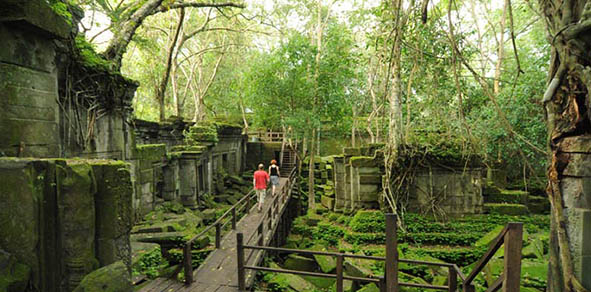
Koh Ker Temple
Koh Ker is located 130km north-east of Siem Reap. It is the site of the capital of Jayavarman IV. The main ruins at Koh Ker consist of a 7-tier pyramid that looks quite out of place in the Cambodian jungle. The temple is currently accessed via a vertiginous wooden ladder and narrow, sloping steps. The climb is worth the effort because of the views from the summit. The surrounding land was irrigated by a Baray similar to those at Angkor but smaller in size. Koh Ker was built in the 10th century and dedicated to Shiva. It receives very few visitors on account of its remoteness and the awful condition of the local roads. Consider contacting a tour guide that specializes in this area or hiring a sturdy dirt-bike. There is a small, friendly restaurant awaiting hardy visitors who brave this trip.
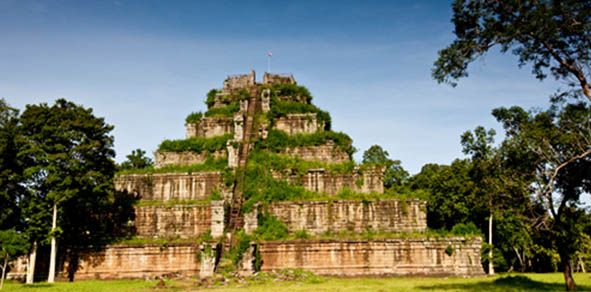
Koulen Mountain
Phnom Kulen is considered by Khmer people to be the most sacred mountain in Cambodia and is a popular place of pilgrimage during weekends a festival. It played a significant role in the history of the Khmer empire, as it was from here in 802 that King Jayavarman II (802-850) proclaimed independence from Java, giving birth to modern- day Cambodia. There is a small wat at the summit of the mountain, which house a large reclining Buddha carved into the sandstone boulder upon which it is built. Nearby is an attractive waterfall in which you can swim and there are a number of carvings in the riverbed, including numerous Lingas. The views from the top are tremendous as you can see right across the forested plateau. The highest point on Phnom Kulen is 487 meters.
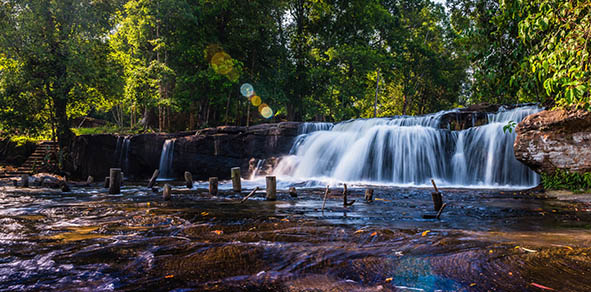
Apsara Performances
No visit to Cambodia is complete without attending at least one traditional Khmer dance performance, often referred to as 'Apsara Dance' after one of the most popular Classical dance pieces. Traditional Khmer dance is better described as 'dance-drama' in that the dances are not merely dance but are also meant to convey a story or message.
The Apsara Dance is a Khmer Classical Dances. This dance helps us experience the tension between earthly groundedness and heavenly lightness.
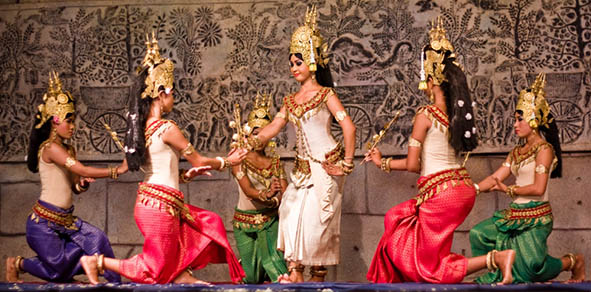
Biking at the Temlpes
Biking is an ideal way to discover the temple of Cambodia and get an accurate impression of the Khmer culture. it will show you the real world of daily life and take you off the beaten track into the heart of the country.
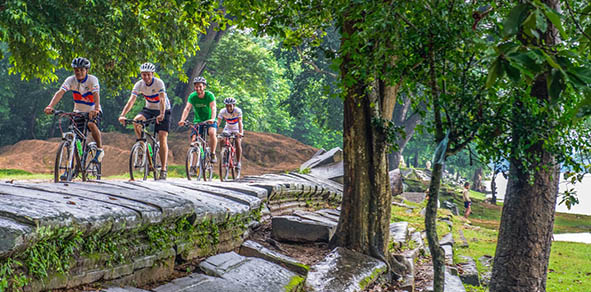
Remork or Tuk Tuk at the Temples
Remork is the Khmer word which is known as TUK TUK, the term Tuk-Tuk is used to refer to a motorcycle with a cabin attached to the rear. Cambodian cities have a much lower volume of automobile traffic than Thai cities, and Tuk-Tuks are still the most common form of urban transport. At the temple complex of Angkor, for example, Tuk-Tuks provide a convenient form of transport around the complex for tourists. One can hire a Tuk-Tuk and driver by the day.
Remork is the Khmer word which is known as TUK TUK, the term Tuk-Tuk is used to refer to a motorcycle with a cabin attached to the rear. Cambodian cities have a much lower volume of automobile traffic than Thai cities, and Tuk-Tuks are still the most common form of urban transport. At the temple complex of Angkor, for example, Tuk-Tuks provide a convenient form of transport around the complex for tourists. One can hire a Tuk-Tuk and driver by the day.
